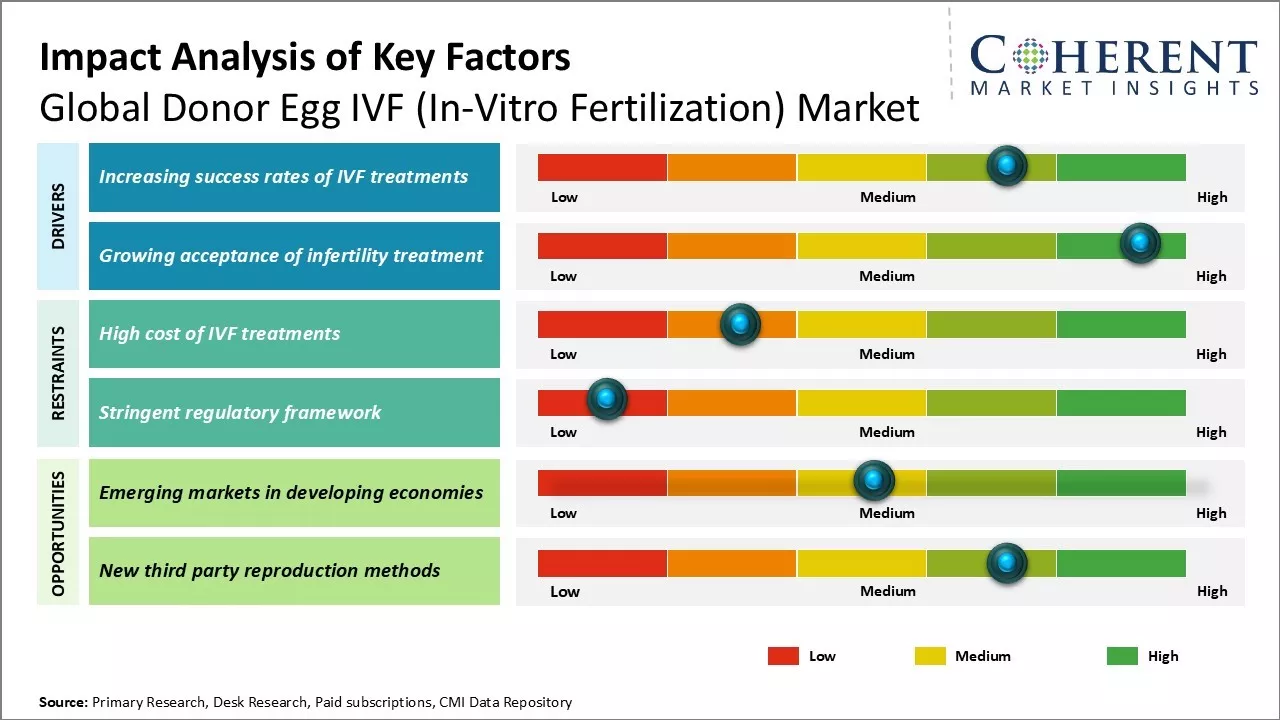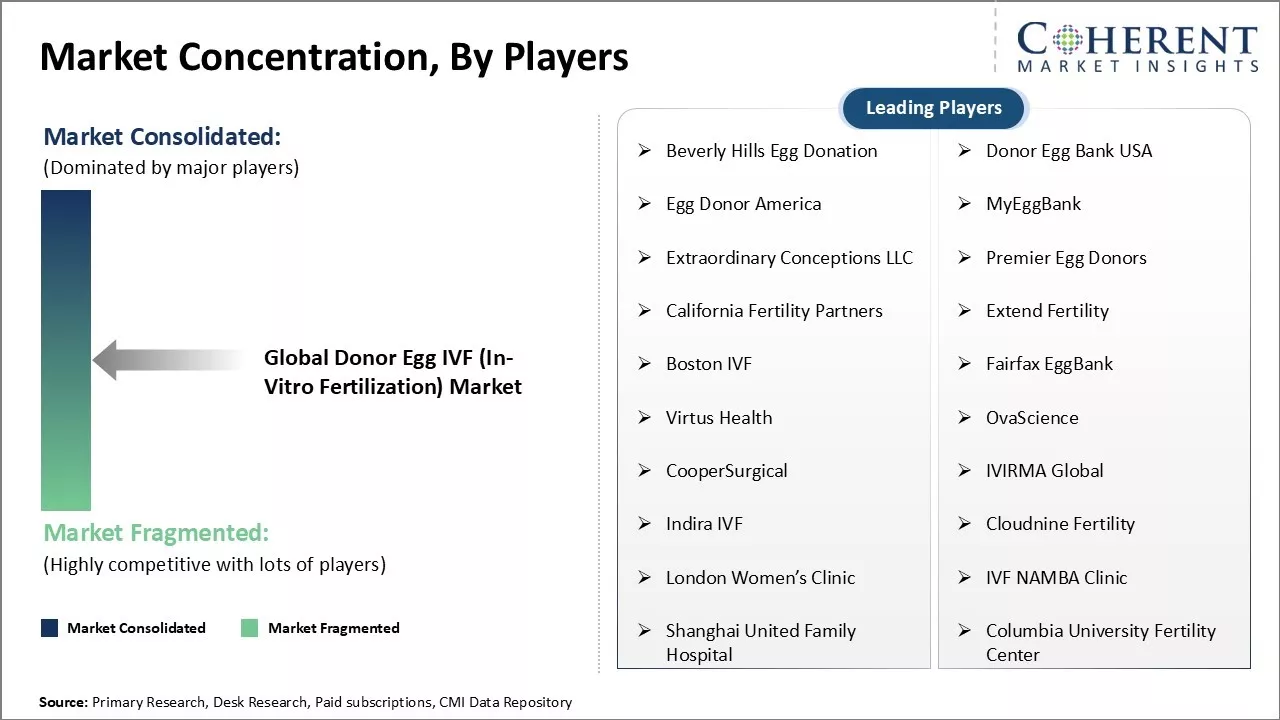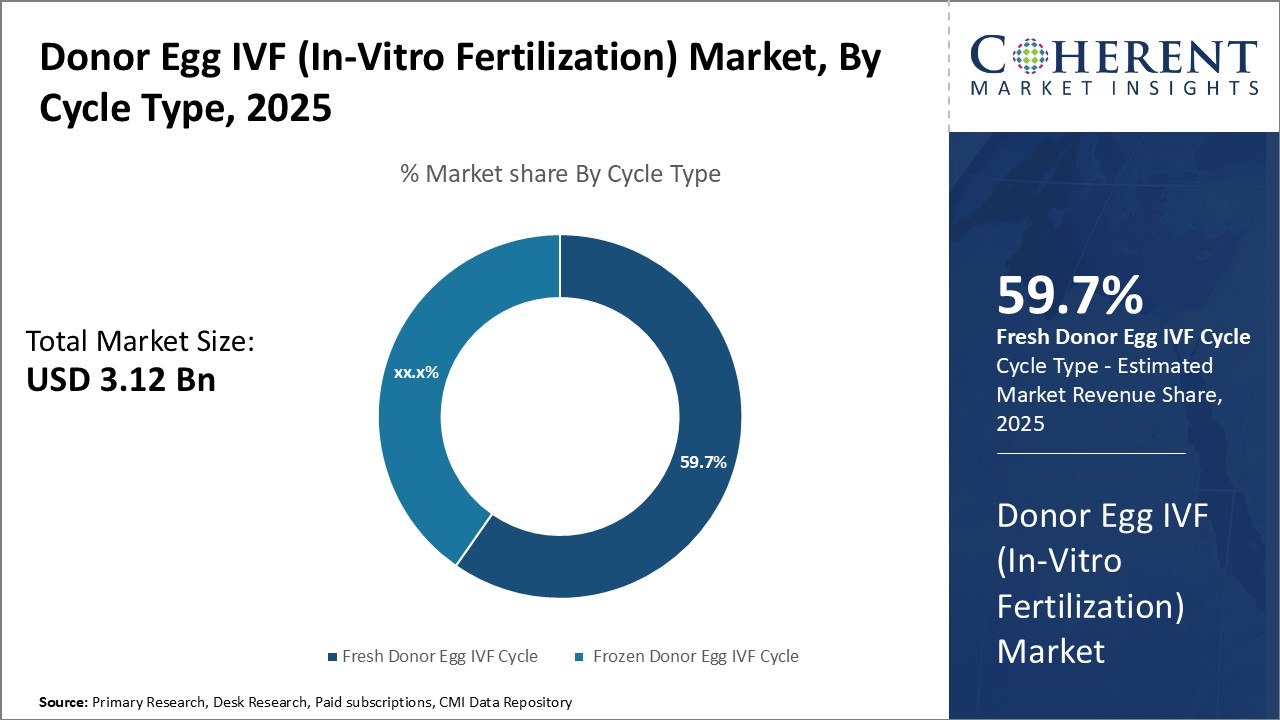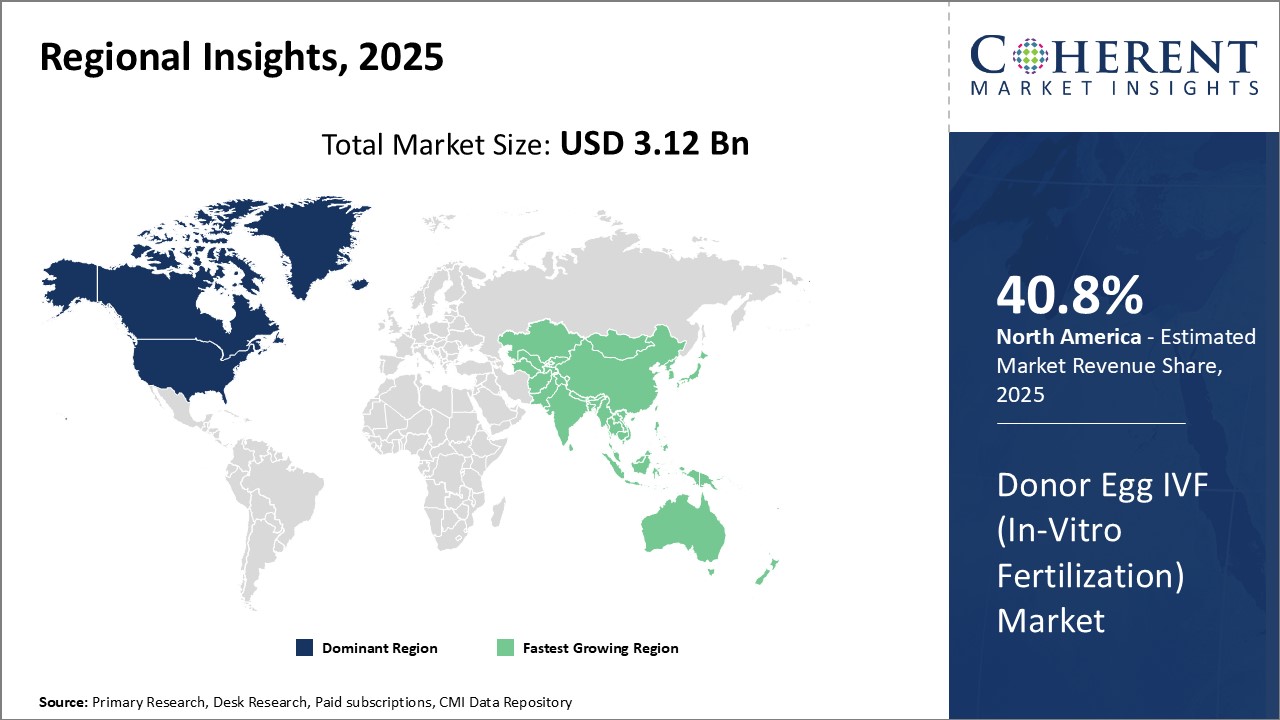Donor Egg IVF (In-Vitro Fertilization) Market Size and Trends
Global donor egg IVF (in-vitro fertilization) market is estimated to be valued at USD 3.12 Bn in 2025 and is expected to reach USD 5.89 Bn by 2032, exhibiting a compound annual growth rate (CAGR) of 9.5% from 2025 to 2032.

Discover market dynamics shaping the industry: Download Free Sample
Global donor egg IVF (in-vitro fertilization) market growth is driven by factors such as surging infertility rates, rising number of couples opting for IVF treatment due to changing lifestyles, and growing acceptance of surrogacy. Furthermore, technological advancements in fertility treatment such as preimplantation genetic diagnosis can improve IVF success rates and meet the growing need of families desiring a biological child.
Increasing success rates of IVF treatments
The success rates of IVF treatments using donor eggs have increased substantially over the past decade. Advancements in assisted reproductive technologies and better understanding of the IVF process have led to significant improvements. Doctors can now monitor and support the growth and development of embryos more effectively outside the body. Success rates for women under 35 years of age using donor eggs are around 60-65% per IVF cycle. This is nearly double the rate from 10 years ago. The high odds of achieving a successful pregnancy encourages more women to opt for donor egg IVF.
Refined laboratory techniques allow for careful screening and selection of healthy eggs from young donors. The selected eggs can be fertilized using intracytoplasmic sperm injection, if required. This optimizes the chances of fertilization. Advanced embryo culture methods help sustain embryo growth in conditions mimicking the uterine environment. Close monitoring of embryonic development aid doctors to select the most viable embryos for transfer. Minimal ovarian stimulation protocols for donors cause less harm. These improvements have resulted in fewer cancellations and higher pregnancy rates per egg retrieval.
As word spreads of others successfully conceiving after multiple failed IVF cycles using their own eggs, there has been growth in perception of donor egg IVF as a viable last option. For instance, in March 2025, according to the data published by the Human Fertilisation and Embryology Authority (HEFA), the U.K.'s fertility treatment has witnessed significant advancements, with over 1.3 million IVF cycles and 260,000 donor insemination cycles performed since 1991, leading to the birth of 390,000 babies. HFEA's 30th anniversary report highlights that IVF cycles had increased from 6,700 in 1991 to over 69,000 in 2019. Birth rates have improved, particularly for patients under age of 43 years, and the multiple birth rate dropped to a record low of 6% in 2019. There has been rise in IVF treatments for patients over age of 40 years, reflecting changing family structures and increased options for creating families.
Market Concentration and Competitive Landscape

Get actionable strategies to beat competition: Download Free Sample
Growing acceptance of infertility treatment
Attitudes towards infertility and its medical management have evolved tremendously in the past two decades. Both men and women now approach infertility diagnosis and treatment more openly without social pressures or stigma. The advent of assistive reproductive techniques has normalized the concept of conceiving with medical help. Greater advocacy and public conversations have fostered wider social support networks for those struggling with fertility issues. Growing public awareness about infertility as a medical challenge, not a personal failing, boosts treatment-seeking behavior.
Changing social values also endorse diverse family formations through assisted reproduction using donor gametes or surrogacy. More countries are legalizing and regulating these options to fulfil parenthood dreams. Same sex couples, single parents and older women are openly choosing these non-traditional routes to build their families. Their voices further normalize discussions around third party assisted concepts like donor conception. Heightened media presence of famous faces sharing their fertility journeys adds another layer of acceptance.
More women are delaying starting families to focus on careers. But these women still aspire for motherhood later in life when natural fertility has declined. This boosts demand for proven solutions like donor egg IVF. Younger fertile women are also inclined to help others through altruistic donation programs. These emerging social trends can boost growth and awareness around infertility treatments globally.
Key Takeaways from Analyst:
Global donor egg IVF (in-vitro fertilization) market growth is driven by rising rates of infertility due to delayed pregnancies and increasing acceptance of surrogacy and IVF globally. Furthermore, increasing success rates of IVF treatments with donor eggs and growing awareness about such treatments can also drive the market growth.
High costs associated with IVF treatments using donor eggs and ethical concerns around surrogacy can hamper the market growth. Lack of reimbursement for such costly treatments can also hamper the spending capabilities of consumers.
North America currently dominates the global donor egg IVF (in-vitro fertilization) market due to growing focus on research and advanced healthcare facilities. Asia Pacific region is estimated to emerge as the fastest growing market, owing to rising infertility rates, improving healthcare infrastructure, and increasing medical tourism in the region.
Growing public-private investments in fertility clinics and ongoing research and developments around egg freezing and newer fertility treatments can offer growth opportunities for market players. Future looks positive for the donor egg IVF market with industry participants focusing on innovations and advancing existing treatments options.
Market Challenge - High cost of IVF treatments
Global donor egg IVF (in-vitro fertilization) market growth can be hampered due to high cost associated with IVF treatments. IVF procedures are generally expensive, ranging anywhere between US$ 12,000 to US$ 15,000 per cycle in many developed markets of North America and Western Europe. The cost includes expenses related to egg retrieval from donors, laboratory procedures for fertilization and embryo transfer, fertility drugs for stimulation and monitoring of cycles. IVF success rates for single cycle are around 30%, thus, requiring multiple cycles for many patients to achieve pregnancy, and this further increases the overall treatment expenses. The financial burden deters many hopeful parents who struggle to afford expensive fertility treatments. Additional costs are incurred if intracytoplasmic sperm injection (ICSI) is required or frozen embryo transfers are included. The high cost act as a growth barrier especially in developing markets where per capita incomes are relatively lower.
Market Opportunity: Emerging markets in developing economies
Global donor egg IVF (in-vitro fertilization) market witness huge opportunity from emerging fertility tourism industry of developing economies. Countries like India, Thailand, Czech Republic, and Mexico have emerged as popular medical tourism destinations for fertility treatments including IVF and egg donation due to significantly lower treatment costs. The treatment expenses for a complete IVF cycle can be as less as one-third of the costs in developed regions. This cost advantage along with world-class fertility clinics practicing latest assisted reproduction techniques has boosted medical tourism arrivals. Thousands of international patients travel to these developing markets every year seeking affordable fertility solutions. Emerging markets provide immense scope for IVF service providers and donor egg banks to expand their share through partnerships with local clinics.

Discover high revenue pocket segments and roadmap to it: Download Free Sample
By Cycle Type - Cost effectiveness boosts demand for fresh donor egg IVF cycle
In terms of cycle type, fresh donor egg IVF cycle segment is estimated to contribute the highest market share of 59.7% in 2025, owing to its relatively lower cost as compared to frozen donor egg IVF cycles. The use of fresh donor eggs eliminates the freezing and thawing process involved in frozen donor egg IVF cycles, thus, making the overall treatment less expensive. Freezing donor eggs for later use involves additional lab procedures and cryopreservation costs, which are passed on to customers. For many recipients and intended parents looking for donor egg IVF, the lower initial financial burden of a fresh donor egg IVF cycle makes it a more attractive option.
The cost effectiveness of fresh donor egg IVF cycles has led to its higher preference, especially among middle- and lower-income groups who want to undergo donor IVF but have limited budgets. For these customers, the upfront affordability granted by fresh cycles allows them to start treatment sooner rather than saving up extra funds required for frozen options. Various clinics and fertility centers also promote fresh donor egg IVF cycles as it allows more price-sensitive customers to opt for donor IVF. Lower treatment costs have a noticeable impact on demand generation.
Convenience is another factor contributing to fresh donor egg IVF cycle segment growth. In many jurisdictions, fresh cycles are more widely available from nearby clinics and fertility banks as compared to frozen cycles which require matching across geographies. This makes scheduling and logistics easier for recipients opting for fresh treatment. With no need to coordinate international egg shipments or inter-clinic transfers, fresh cycles provide a simpler experience to customers in terms of treatment timeline and planning. The convenience boosts their appeal over frozen options for working professionals and young families juggling busy lifestyles along with fertility treatment.
By Pricing Model - Bundled packages cater to "one-and-done" mentality under pay-per-cycle pricing
In terms of pricing model, pay-per-cycle segment is estimated to contribute the highest market share of 43.9% in 2025. Bundled Package segment is growing faster, owing to its ability to satisfy customers wanting a "one-and-done" donor egg IVF experience.
Under pay-per-cycle model, recipients pay a la carte for each stimulation, retrieval, transfer, or storage cycle. While this provides flexibility, it often results in multiple treatment attempts spread over several months or years to achieve success. This prolonged process comes at a higher total cost and extended emotional toll on customers.
Bundled Packages offer flat rates for a guaranteed number of back-to-back full IVF cycles booked in advance. Clinics bundle costs of medications, laboratory fees, coordination, and other ancillaries into competitive package prices. This caters well to the convenience and peace of mind needs of customers who want a definitive timeline to conception rather than drawn out per-cycle billing. The assurance of multiple funded cycles upfront in a bundle allows many people to avoid the psychological stresses of failed cycles with no options left.
As more recipients realize the total expense of individual pay-per-cycle plans exceeds bundled rates even after multiple attempts, the attractiveness of guaranteed bundles increases. Strategic discounting and financing options on packages further boost their value proposition. This growth in preference for definitive bundled plans over intermittent pay-per-cycle can drive the bundled package segment.
By Age Group - Younger age-groups boost demand in the crucial 21-35 years bracket
In terms of age group, 21-35 years segment is estimated to contribute the highest market share of 42.8% in 2025, due to the importance of timing for intended parents in this critical fertility window. Delaying motherhood is a modern phenomenon that has increased medical needs and demand for fertility assistance during the most fertile years.
The high-powered careers, educational pursuits and urban lifestyles adopted by millennials and Gen Z in developed nations lead many people to start families later than previous generations. However, fertility appreciably declines after the mid-30s mark for majority of women. The awareness around this biological clock as well as changing social outlooks make people in their late 20s to mid-30s highly focused on quickly building their families.
Younger demographics are generally more socially liberal and open to new concepts like donor-conception. These have less hesitation than older cohorts in freely discussing infertility issues and appreciating donor egg IVF as a viable path for parenthood within recommended timelines. Peer and community support also plays a role as discussions around family planning, egg freezing and third-party reproduction become more prominent online.
These socio-cultural factors converge to fuel the urgency in many 21-35 year-old career-oriented women and couples to pursue donor IVF promptly before their natural fertility window closes. This makes the 21-35 years bracket age crucial for IVF clinics seeking to capture the market during its most opportune stage of life. Timely access to high-quality donor eggs enables more recipients to achieve pregnancies well within the prime fertile years.
Regional Insights

Need a Different Region or Segment? Download Free Sample
North America dominates the global donor egg IVF (in-vitro fertilization) market with an estimated market share of 40.8% in 2025, due to strong industry presence and favourable reimbursement policies. The U.S. accounts for majority of market share in the region, owing to growing acceptance of third-party reproduction and presence of major industry players. Many leading fertility clinics in the country offer donor egg programs that attract patients from other parts of the world as well. Flexible financing options make critical infertility treatments affordable for residents. This has boosted demand. Though regulations vary at state level, overall supportive regulatory environment and patent protection for new techniques have encouraged ongoing R&D investments.
Asia Pacific region is poised to be the fastest growing market during the forecast period. Countries like China, India and Japan can drive the market growth due to rising infertility rates attributable to changing lifestyle habits. Growing medical tourism also attracts patients from foreign countries to available fertility treatments at lower costs. While practices are new to some eastern cultures, changing social attitudes and strong economic growth are helping overcome taboos. Governments in various developing nations have formulated favorable guidelines to regulate this sector and promote domestic innovation. Regional players are partnering with global in-vitro fertilization providers to transfer technologies and skills. This is expected to boost localized production and research capabilities to cater to future needs. Improving accessibility in tier 2 and 3 cities further expands the potential patient pool.
Market Report Scope
Donor Egg IVF (In-Vitro Fertilization) Market Report Coverage
| Report Coverage | Details | ||
|---|---|---|---|
| Base Year: | 2024 | Market Size in 2025: | USD 3.12 Bn |
| Historical Data for: | 2020 To 2024 | Forecast Period: | 2025 To 2032 |
| Forecast Period 2025 to 2032 CAGR: | 9.5% | 2032 Value Projection: | USD 5.89 Bn |
| Geographies covered: |
|
||
| Segments covered: |
|
||
| Companies covered: |
Beverly Hills Egg Donation, Donor Egg Bank USA, Egg Donor America, MyEggBank, Extraordinary Conceptions LLC, Premier Egg Donors, California Fertility Partners, Extend Fertility, Boston IVF, Fairfax EggBank, Virtus Health, OvaScience, CooperSurgical, IVIRMA Global, Indira IVF, Cloudnine Fertility, London Women’s Clinic, IVF NAMBA Clinic, Shanghai United Family Hospital, Columbia University Fertility Center |
||
| Growth Drivers: |
|
||
| Restraints & Challenges: |
|
||
Uncover macros and micros vetted on 75+ parameters: Get instant access to report
Donor Egg IVF (In-Vitro Fertilization) Industry News
- In February 2024, Fertility Centers of New England, Inc. acquired Fertility Solutions, a well-regarded fertility clinic with locations in Massachusetts and Rhode Island. This acquisition represents a key step in FCNE's mission to expand patient access to advanced fertility treatments and increase its geographic presence.
- In August 2023, Shady Grove Fertility introduced an enhanced Donor Egg Program, offering a flat fee for six eggs from a Shady Grove Fertility donor, either fresh or frozen, with additional eggs available at a per-egg cost. Eligible patients are guaranteed at least one blastocyst embryo. This initiative is designed to boost customer satisfaction and drive revenue growth for the company.
*Definition: Global Donor Egg IVF (In-Vitro Fertilization) Market involves the process of fertilizing an egg provided by a donor with sperm from the intended parent through in-vitro fertilization, and then transferring the resulting embryo(s) into the intended mother's womb.
Market Segmentation
- By Cycle Type Insights (Revenue, USD Bn, 2020 - 2032)
-
- Fresh Donor Egg IVF Cycle
- Frozen Donor Egg IVF Cycle
- By Pricing Model Insights (Revenue, USD Bn, 2020 - 2032)
-
- Pay-Per-Cycle
- Bundled Package
- By Age Group Insights (Revenue, USD Bn, 2020 - 2032)
-
- 21-35 Years
- 36-40 Years
- 41-45 Years
- By End User Insights (Revenue, USD Bn, 2020 - 2032)
-
- Fertility Clinics
- Hospitals
- Surgical Centers
- Others
- Regional Insights (Revenue, USD Bn 2020 - 2032)
- North America
- U.S.
- Canada
- Latin America
- Brazil
- Argentina
- Mexico
- Rest of Latin America
- Europe
- Germany
- U.K.
- Spain
- France
- Italy
- Russia
- Rest of Europe
- Asia Pacific
- China
- India
- Japan
- Australia
- South Korea
- ASEAN
- Rest of Asia Pacific
- Middle East
- GCC Countries
- Israel
- Rest of Middle East
- Africa
- South Africa
- North Africa
- Central Africa
- North America
- Key Players Insights
- Beverly Hills Egg Donation
- Donor Egg Bank USA
- Egg Donor America
- MyEggBank
- Extraordinary Conceptions LLC
- Premier Egg Donors
- California Fertility Partners
- Extend Fertility
- Boston IVF
- Fairfax EggBank
- Virtus Health
- OvaScience
- CooperSurgical
- IVIRMA Global
- Indira IVF
- Cloudnine Fertility
- London Women’s Clinic
- IVF NAMBA Clinic
- Shanghai United Family Hospital
- Columbia University Fertility Center
Share
Share
About Author
Vipul Patil is a dynamic management consultant with 6 years of dedicated experience in the pharmaceutical industry. Known for his analytical acumen and strategic insight, Vipul has successfully partnered with pharmaceutical companies to enhance operational efficiency, cross broader expansion, and navigate the complexities of distribution in markets with high revenue potential.
Missing comfort of reading report in your local language? Find your preferred language :
Transform your Strategy with Exclusive Trending Reports :
Frequently Asked Questions
EXISTING CLIENTELE
Joining thousands of companies around the world committed to making the Excellent Business Solutions.
View All Our Clients
